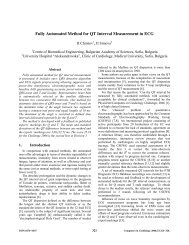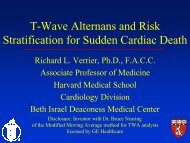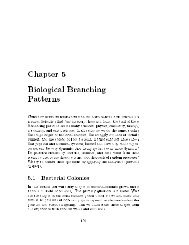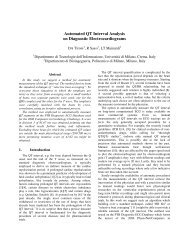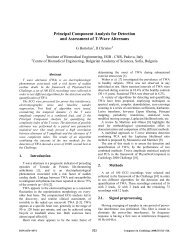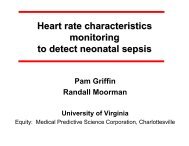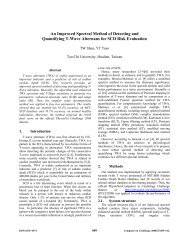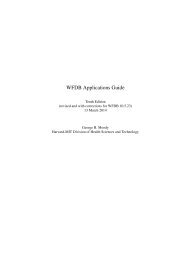Discussion on an XML-based open file format for PSG - PhysioNet
Discussion on an XML-based open file format for PSG - PhysioNet
Discussion on an XML-based open file format for PSG - PhysioNet
You also want an ePaper? Increase the reach of your titles
YUMPU automatically turns print PDFs into web optimized ePapers that Google loves.
Workshop to develop guidelines <strong>for</strong> Electr<strong>on</strong>ic Interch<strong>an</strong>ge of Polysomnography Data<br />
OpenXDF<br />
<str<strong>on</strong>g>Discussi<strong>on</strong></str<strong>on</strong>g> <strong>on</strong> <strong>an</strong> <strong>XML</strong>-<strong>based</strong><br />
<strong>open</strong> <strong>file</strong> <strong><strong>for</strong>mat</strong> <strong>for</strong> <strong>PSG</strong><br />
Neurotr<strong>on</strong>ics Incorporated<br />
Email: sales@neurotr<strong>on</strong>ics.com<br />
Mailing Address:<br />
102 NE 10th Avenue STE 5<br />
Gainesville, FL 32601, USA<br />
J<strong>an</strong>uary 27, 2006 Philadelphia, PA www.<strong>open</strong>xdf.org<br />
1
Workshop to develop guidelines <strong>for</strong> Electr<strong>on</strong>ic Interch<strong>an</strong>ge of Polysomnography Data<br />
What is OpenXDF?<br />
<br />
<br />
<br />
<br />
An <strong>open</strong> st<strong>an</strong>dard <strong>for</strong> the digital storage of time-series<br />
physiological signals <strong>an</strong>d <strong>an</strong>notati<strong>on</strong>s. Its primary focus is <strong>on</strong><br />
electroencephalography <strong>an</strong>d polysomnography.<br />
OpenXDF is <strong>based</strong> <strong>on</strong> <strong>XML</strong> which has become a widely accepted<br />
st<strong>an</strong>dard <strong>for</strong> the digital storage of data. <strong>XML</strong> was adopted by the<br />
World Wide Web C<strong>on</strong>sortium (W3C) in 1998 <strong>for</strong> data exch<strong>an</strong>ge<br />
over the Internet. Since then, m<strong>an</strong>y industries have developed<br />
st<strong>an</strong>dardized data exch<strong>an</strong>ge <strong>an</strong>d storage <strong><strong>for</strong>mat</strong>s <strong>based</strong> <strong>on</strong> <strong>XML</strong>.<br />
The FDA has proposed <strong>an</strong> <strong>XML</strong>-<strong>based</strong> st<strong>an</strong>dard <strong>for</strong> submissi<strong>on</strong> of<br />
ECG data used in studies.<br />
Internati<strong>on</strong>al Federati<strong>on</strong> of Clinical Neurophysiology (IFCN)<br />
st<strong>an</strong>dards <strong>for</strong> digital recording of clinical EEG,<br />
Electroencephalography <strong>an</strong>d clinical Neurophysiology 106 (1998)<br />
259–261<br />
http://www1.elsevier.com/homepage/sah/ifcn/pdf/106_259.pdf<br />
J<strong>an</strong>uary 27, 2006 Philadelphia, PA www.<strong>open</strong>xdf.org<br />
2
Workshop to develop guidelines <strong>for</strong> Electr<strong>on</strong>ic Interch<strong>an</strong>ge of Polysomnography Data<br />
Design C<strong>on</strong>siderati<strong>on</strong>s<br />
<br />
<br />
<br />
<br />
<br />
<br />
Multi-byte character encoding (all l<strong>an</strong>guage support)<br />
Support unlimited number of ch<strong>an</strong>nels<br />
Ch<strong>an</strong>nel specific sampling rate, r<strong>an</strong>ge, <strong>an</strong>d bytes-persample<br />
Well-defined st<strong>an</strong>dard <strong>for</strong> storing comm<strong>on</strong> in<strong><strong>for</strong>mat</strong>i<strong>on</strong><br />
(m<strong>on</strong>tages, events, scoring) Ability to store proprietary<br />
or n<strong>on</strong>-st<strong>an</strong>dard in<strong><strong>for</strong>mat</strong>i<strong>on</strong><br />
Exp<strong>an</strong>dability with 100% backward <strong>an</strong>d <strong>for</strong>ward<br />
compatibility<br />
Encrypti<strong>on</strong> <strong>for</strong> HIPAA compli<strong>an</strong>ce<br />
J<strong>an</strong>uary 27, 2006 Philadelphia, PA www.<strong>open</strong>xdf.org<br />
3
Workshop to develop guidelines <strong>for</strong> Electr<strong>on</strong>ic Interch<strong>an</strong>ge of Polysomnography Data<br />
Design C<strong>on</strong>siderati<strong>on</strong>s C<strong>on</strong>t.<br />
<br />
<br />
<br />
<br />
<br />
<br />
<br />
Must store the original sampled signal<br />
Support unipolar, bipolar, <strong>an</strong>d DC signals<br />
Files should be as few <strong>an</strong>d as small as possible<br />
Should be simple to implement <strong>for</strong> maximum<br />
accept<strong>an</strong>ce<br />
Should be backward compatible with current st<strong>an</strong>dard<br />
(EDF)<br />
Support disc<strong>on</strong>tinuous data <strong>an</strong>d multiple <strong>file</strong>s per<br />
record (MSLT, MWT)<br />
Should be adaptable to Neurology <strong>for</strong> routine EEGs <strong>an</strong>d<br />
l<strong>on</strong>g term m<strong>on</strong>itoring etc.<br />
J<strong>an</strong>uary 27, 2006 Philadelphia, PA www.<strong>open</strong>xdf.org<br />
4
Workshop to develop guidelines <strong>for</strong> Electr<strong>on</strong>ic Interch<strong>an</strong>ge of Polysomnography Data<br />
Two <strong>file</strong> implementati<strong>on</strong><br />
<br />
<strong>XML</strong> header <strong>file</strong> including<br />
<br />
<br />
<br />
<br />
Patient in<strong><strong>for</strong>mat</strong>i<strong>on</strong><br />
Events, <strong>an</strong>notati<strong>on</strong>s, scoring results<br />
M<strong>on</strong>tage(s)<br />
Binary <strong>file</strong> descripti<strong>on</strong><br />
<br />
Binary data <strong>file</strong> including<br />
<br />
Digitally sampled physiological data<br />
J<strong>an</strong>uary 27, 2006 Philadelphia, PA www.<strong>open</strong>xdf.org<br />
5
Workshop to develop guidelines <strong>for</strong> Electr<strong>on</strong>ic Interch<strong>an</strong>ge of Polysomnography Data<br />
Why <strong>XML</strong><br />
Extensible<br />
Backward <strong>an</strong>d <strong>for</strong>ward compatible<br />
Able to accommodate proprietary in<strong><strong>for</strong>mat</strong>i<strong>on</strong><br />
Easily exp<strong>an</strong>dable<br />
Widely accepted st<strong>an</strong>dard<br />
J<strong>an</strong>uary 27, 2006 Philadelphia, PA www.<strong>open</strong>xdf.org<br />
6
Workshop to develop guidelines <strong>for</strong> Electr<strong>on</strong>ic Interch<strong>an</strong>ge of Polysomnography Data<br />
Why Binary Data File<br />
<br />
Backwards compatible with EDF <strong>an</strong>d possibly other<br />
<strong><strong>for</strong>mat</strong>s<br />
<br />
Binary is the most compact way to store data while<br />
preserving the original in<strong><strong>for</strong>mat</strong>i<strong>on</strong><br />
<br />
Fast retrieval <strong>an</strong>d processing <strong>for</strong> display<br />
J<strong>an</strong>uary 27, 2006 Philadelphia, PA www.<strong>open</strong>xdf.org<br />
7
Workshop to develop guidelines <strong>for</strong> Electr<strong>on</strong>ic Interch<strong>an</strong>ge of Polysomnography Data<br />
OpenXDF Encrypti<strong>on</strong><br />
<br />
<br />
RC-4 128-bit encrypti<strong>on</strong><br />
Encrypti<strong>on</strong> of the <strong>XML</strong> header <strong>file</strong> with a proprietary<br />
<strong>an</strong>d/or password key<br />
<br />
<br />
Proprietary key allows reading by originating software <strong>on</strong>ly<br />
Password key allows reading by <strong>an</strong>y<strong>on</strong>e with the password<br />
<br />
Type of key <strong>an</strong>d password is user selectable.<br />
J<strong>an</strong>uary 27, 2006 Philadelphia, PA www.<strong>open</strong>xdf.org<br />
8
Workshop to develop guidelines <strong>for</strong> Electr<strong>on</strong>ic Interch<strong>an</strong>ge of Polysomnography Data<br />
OpenXDF Features<br />
<br />
<br />
<br />
<br />
<br />
<br />
<br />
Support <strong>for</strong> multiple scorers<br />
Supports multiple <strong>file</strong>s <strong>an</strong>d multiple sessi<strong>on</strong>s per <strong>file</strong><br />
Stores last used m<strong>on</strong>tage <strong>an</strong>d as acquired m<strong>on</strong>tage(s)<br />
Supports variable sampling rates <strong>an</strong>d variable signal r<strong>an</strong>ge<br />
Backwards compatible with EDF<br />
Free OpenXDF/EDF reader<br />
Free development tools<br />
J<strong>an</strong>uary 27, 2006 Philadelphia, PA www.<strong>open</strong>xdf.org<br />
9
Workshop to develop guidelines <strong>for</strong> Electr<strong>on</strong>ic Interch<strong>an</strong>ge of Polysomnography Data<br />
OpenXDF Benefits<br />
<br />
<br />
<br />
<br />
<br />
<br />
<br />
<br />
<br />
Using <strong>an</strong> extensible <strong><strong>for</strong>mat</strong> will allow OpenXDF to be both backward <strong>an</strong>d <strong>for</strong>ward<br />
compatible <strong>an</strong>d allow <strong>for</strong> unlimited exp<strong>an</strong>si<strong>on</strong>. Since the protocol has a basis in<br />
<strong>XML</strong>, there will be fewer limitati<strong>on</strong>s, making integrati<strong>on</strong> into existing systems<br />
easier. Some adv<strong>an</strong>tages of using <strong>XML</strong> are:<br />
Both st<strong>an</strong>dard <strong>an</strong>d proprietary in<strong><strong>for</strong>mat</strong>i<strong>on</strong> c<strong>an</strong> be stored in the <strong>file</strong> without<br />
affecting compatibility<br />
No limitati<strong>on</strong>s <strong>on</strong> <strong>an</strong>notati<strong>on</strong>s or scoring in<strong><strong>for</strong>mat</strong>i<strong>on</strong><br />
No limitati<strong>on</strong>s <strong>on</strong> patient in<strong><strong>for</strong>mat</strong>i<strong>on</strong><br />
There is no limitati<strong>on</strong> <strong>on</strong> string lengths, <strong>an</strong>d <strong>on</strong>ly loose limitati<strong>on</strong>s <strong>on</strong> sample<br />
sizes (1, 2, 4, <strong>an</strong>d 8 bytes) <strong>an</strong>d frequencies<br />
Text encoding <strong>an</strong>d l<strong>an</strong>guage support is not limited by <strong>XML</strong><br />
Uses ISO8601 <strong>for</strong> robust, uni<strong>for</strong>m, Y2K compli<strong>an</strong>t date/time representati<strong>on</strong><br />
Allows <strong>for</strong> data encrypti<strong>on</strong><br />
To make adopti<strong>on</strong> easier, software c<strong>on</strong>verters will be written <strong>for</strong> existing <strong>open</strong><br />
<strong>file</strong> <strong><strong>for</strong>mat</strong>s such as EDF. C<strong>on</strong>verters <strong>for</strong> other <strong><strong>for</strong>mat</strong>s c<strong>an</strong> be produced in a<br />
short period of time if the existing <strong>file</strong> <strong><strong>for</strong>mat</strong> is made available.<br />
J<strong>an</strong>uary 27, 2006 Philadelphia, PA www.<strong>open</strong>xdf.org<br />
10
Workshop to develop guidelines <strong>for</strong> Electr<strong>on</strong>ic Interch<strong>an</strong>ge of Polysomnography Data<br />
XDFviewer by Neurotr<strong>on</strong>ics, Incorporated<br />
<br />
XDFviewer is a light-weight, intuitive applicati<strong>on</strong> <strong>for</strong><br />
viewing Open eXch<strong>an</strong>ge Data Format (OpenXDF) <strong>an</strong>d<br />
Europe<strong>an</strong> Data Format (EDF/+) <strong>file</strong>s <strong>on</strong> Microsoft<br />
Windows TM plat<strong>for</strong>ms.<br />
<br />
XDFviewer incorporates elements of successful<br />
commercial <strong>PSG</strong> <strong>an</strong>d EEG software to provide<br />
collaborative research <strong>an</strong>d diagnostic ef<strong>for</strong>ts with a<br />
powerful, easy-to-use, FREE viewer.<br />
J<strong>an</strong>uary 27, 2006 Philadelphia, PA www.<strong>open</strong>xdf.org<br />
11
Workshop to develop guidelines <strong>for</strong> Electr<strong>on</strong>ic Interch<strong>an</strong>ge of Polysomnography Data<br />
XDFviewer c<strong>on</strong>t.<br />
<br />
<br />
XDFviewer provides the following features <strong>for</strong> both OpenXDF AND EDF <strong>file</strong>s:<br />
32 display ch<strong>an</strong>nels<br />
An electrode editor <strong>for</strong> editing source electrode properties<br />
An intuitive m<strong>on</strong>tage editor<br />
On-plot polarity, filter, <strong>an</strong>d sensitivity settings<br />
Fast high-pass, low-pass, <strong>an</strong>d notch (50/60Hz) filters<br />
10s, 15s, 20s, 30s, 1m, 2m, <strong>an</strong>d 5m time bases<br />
EEG-style (6mm) time reference lines of 1/2s, 1s, 5s etc.<br />
Intuitive <strong>file</strong> navigati<strong>on</strong><br />
C<strong>on</strong>figurable display colors<br />
Supports disjoint recording sessi<strong>on</strong>s within a data <strong>file</strong><br />
Annotati<strong>on</strong> display (event log)**<br />
Printing<br />
XDFviewer provides the following additi<strong>on</strong>al features <strong>for</strong> OpenXDF <strong>file</strong>s:<br />
Supports displaying multiple data <strong>file</strong>s as <strong>on</strong>e c<strong>on</strong>tinuous plot<br />
Highlighted events<br />
Extended patient in<strong><strong>for</strong>mat</strong>i<strong>on</strong><br />
J<strong>an</strong>uary 27, 2006 Philadelphia, PA www.<strong>open</strong>xdf.org<br />
12
Workshop to develop guidelines <strong>for</strong> Electr<strong>on</strong>ic Interch<strong>an</strong>ge of Polysomnography Data<br />
The OpenXDF / EDF Viewer http://www.<strong>open</strong>xdf.org/viewer.html<br />
Main plot display with highlighted events<br />
J<strong>an</strong>uary 27, 2006 Philadelphia, PA www.<strong>open</strong>xdf.org<br />
13
Workshop to develop guidelines <strong>for</strong> Electr<strong>on</strong>ic Interch<strong>an</strong>ge of Polysomnography Data<br />
Patient In<strong><strong>for</strong>mat</strong>i<strong>on</strong><br />
J<strong>an</strong>uary 27, 2006 Philadelphia, PA www.<strong>open</strong>xdf.org<br />
14
Workshop to develop guidelines <strong>for</strong> Electr<strong>on</strong>ic Interch<strong>an</strong>ge of Polysomnography Data<br />
Electrode Editor<br />
J<strong>an</strong>uary 27, 2006 Philadelphia, PA www.<strong>open</strong>xdf.org<br />
15
Workshop to develop guidelines <strong>for</strong> Electr<strong>on</strong>ic Interch<strong>an</strong>ge of Polysomnography Data<br />
M<strong>on</strong>tage Editor<br />
J<strong>an</strong>uary 27, 2006 Philadelphia, PA www.<strong>open</strong>xdf.org<br />
16
On-plot Workshop polarity, to develop guidelines filter, <strong>for</strong> <strong>an</strong>d Electr<strong>on</strong>ic sensitivity Interch<strong>an</strong>ge of settings<br />
Polysomnography Data<br />
J<strong>an</strong>uary 27, 2006 Philadelphia, PA www.<strong>open</strong>xdf.org<br />
17
Workshop to develop guidelines <strong>for</strong> Electr<strong>on</strong>ic Interch<strong>an</strong>ge of Polysomnography Data<br />
5 minute view with events<br />
Electrode Editor<br />
J<strong>an</strong>uary 27, 2006 Philadelphia, PA www.<strong>open</strong>xdf.org<br />
18
Workshop to develop guidelines <strong>for</strong> Electr<strong>on</strong>ic Interch<strong>an</strong>ge of Polysomnography Data<br />
Printing<br />
J<strong>an</strong>uary 27, 2006 Philadelphia, PA www.<strong>open</strong>xdf.org<br />
19
Workshop to develop guidelines <strong>for</strong> Electr<strong>on</strong>ic Interch<strong>an</strong>ge of Polysomnography Data<br />
XDFviewer <str<strong>on</strong>g>Discussi<strong>on</strong></str<strong>on</strong>g><br />
<br />
Since <strong>XML</strong> uses text tags to describe c<strong>on</strong>tent, it creates<br />
larger <strong>file</strong>s th<strong>an</strong> comparable binary storage <strong><strong>for</strong>mat</strong>s.<br />
<br />
For polygraph recordings this increase in <strong>file</strong> size would be<br />
prohibitive. If the binary wave<strong>for</strong>m data is stored separately<br />
from the descriptive data, (ie. patient in<strong><strong>for</strong>mat</strong>i<strong>on</strong>, m<strong>on</strong>tages,<br />
<strong>an</strong>d <strong>an</strong>notati<strong>on</strong>s) this problem is alleviated. By keeping the<br />
wave<strong>for</strong>m data in a separate <strong>file</strong>, there is the added adv<strong>an</strong>tage<br />
of adapting existing <strong><strong>for</strong>mat</strong>s without c<strong>on</strong>verting the binary<br />
wave<strong>for</strong>m data. This would make <strong>for</strong> easier integrati<strong>on</strong> into<br />
existing systems <strong>an</strong>d would eliminate the risk of distorting the<br />
data up<strong>on</strong> c<strong>on</strong>versi<strong>on</strong>. For example, it will be possible to create<br />
the <strong>XML</strong> descriptor <strong>file</strong> from <strong>an</strong> existing EDF <strong>file</strong> without<br />
ch<strong>an</strong>ging the original <strong>file</strong>. This will make OpenXDF backward<br />
compatible with EDF <strong>an</strong>d possibly other <strong><strong>for</strong>mat</strong>s.<br />
J<strong>an</strong>uary 27, 2006 Philadelphia, PA www.<strong>open</strong>xdf.org<br />
20
Workshop to develop guidelines <strong>for</strong> Electr<strong>on</strong>ic Interch<strong>an</strong>ge of Polysomnography Data<br />
XDFviewer <str<strong>on</strong>g>Discussi<strong>on</strong></str<strong>on</strong>g> c<strong>on</strong>t.<br />
<br />
<br />
<br />
Separating the descriptive data from the binary wave<strong>for</strong>m<br />
data also allows multiple wave<strong>for</strong>m <strong>file</strong>s to be linked<br />
together under <strong>on</strong>e OpenXDF header <strong>file</strong>.<br />
<strong>XML</strong> <strong>file</strong>s are hum<strong>an</strong> readable by design, but this feature<br />
is not always desirable <strong>for</strong> security reas<strong>on</strong>s. Thus,<br />
software comp<strong>on</strong>ents will be created to facilitate<br />
encrypti<strong>on</strong> of sensitive patient in<strong><strong>for</strong>mat</strong>i<strong>on</strong> <strong>an</strong>d password<br />
protect <strong>file</strong>s. This opti<strong>on</strong> will be user-c<strong>on</strong>figurable <strong>for</strong><br />
maximum flexibility.<br />
The security comp<strong>on</strong>ent will be a st<strong>an</strong>dard add-<strong>on</strong><br />
comp<strong>on</strong>ent that c<strong>an</strong> easily be integrated into existing<br />
systems.<br />
J<strong>an</strong>uary 27, 2006 Philadelphia, PA www.<strong>open</strong>xdf.org<br />
21
Workshop to develop guidelines <strong>for</strong> Electr<strong>on</strong>ic Interch<strong>an</strong>ge of Polysomnography Data<br />
Opini<strong>on</strong>s of Claude Albertario, R<strong>PSG</strong>T<br />
“It should all be a Web browser viewer.”<br />
<br />
<br />
<br />
<br />
<br />
<br />
<br />
The acquisiti<strong>on</strong> should be a system that utilizes a SSL web browser<br />
interface to c<strong>on</strong>trol the hardware.<br />
Using this scenario allows the data to exist outside of the recorder,<br />
<strong>an</strong>d/or a specific “software.”<br />
“Template viewers” would be created by m<strong>an</strong>ufacturers so that the<br />
usage of their template could be through payment/licensure.<br />
This template viewer c<strong>on</strong>trols how <strong>on</strong>e interacts with said recorded<br />
data.<br />
Coupled with export functi<strong>on</strong>s <strong>for</strong> demographic data, scoring, etc.,<br />
this af<strong>for</strong>ds c<strong>on</strong>sistency of acquisiti<strong>on</strong> across laboratories, ability to<br />
exch<strong>an</strong>ge XDF data <strong>file</strong>s across templates independent of systems,<br />
<strong>an</strong>d a thriving market <strong>for</strong> a “better mousetrap” (viewer.)<br />
This then helps ensure competiti<strong>on</strong> <strong>an</strong>d technological adv<strong>an</strong>cement,<br />
benefiting the field <strong>an</strong>d not just market niches.<br />
Acquisiti<strong>on</strong> system m<strong>an</strong>ufacturers would not require heavy<br />
investments, <strong>an</strong>d Template m<strong>an</strong>ufacturers would be <strong>for</strong>ced to<br />
c<strong>on</strong>st<strong>an</strong>tly improve their product.<br />
J<strong>an</strong>uary 27, 2006 Philadelphia, PA www.<strong>open</strong>xdf.org<br />
22




